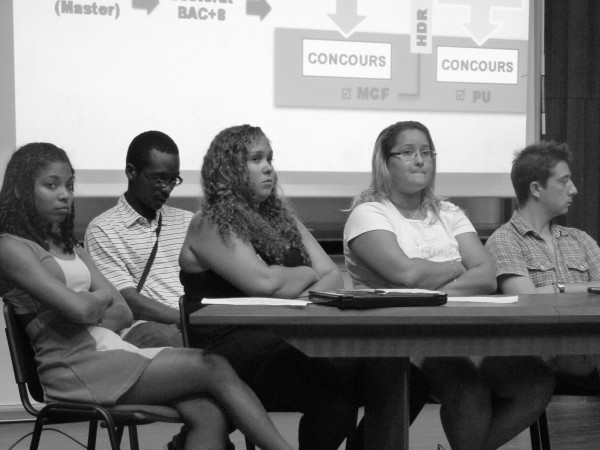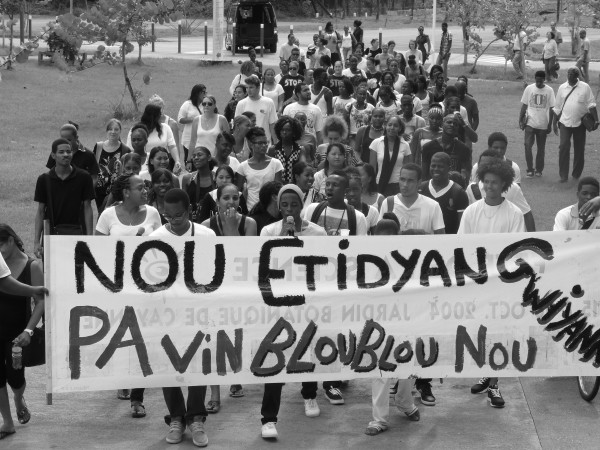Examining a speech not made by André Malraux in Cayenne, Pierre Michelon focuses on a signature episode in the history of the departmentalization of French Guyana: the September 1958 referendum on the Constitution of the 5th Repubic. « A small piece of wood » considers this account in all its many versions: according to the Independents, the Communists, the Gaullists, the ministers, or all versions at once. This is the case with Jean Mariema, an important figure in Guyanese militancy, with whom Pierre Michelon constructs this model for a film. For the evening of performance-documentary on Monday, March 31st (Phantom Monday n°11), he collaborates with David Legrand and invites Françoise Vergès and Mathieu K. Abonnenc to share in the discussion. To accompany this work in progress, Pierre Michelon has assembled texts and documents that shed light, each in its own manner, on the different points of his research.
11/11/13 > 28/03/14
“The article you are about to read was written on the night of November 11-12, 2013, a few hours after the signing of the historic accord which ended the strike of students, personnel and teachers and saw the birth of the University of Guyana. And so this assessment, which I wrote as an engaged actor in this movement, since I a member of the campus inter-union group and a representative of the STEG-UTG, the teachers’ union affiliated with the principal Guyanese central unit, is very much up to date. The article initially appeared in L’anticapitaliste, the NPA newspaper in France.”
11/11/13 University of Guyana: total victory for the strikers
In (French) Guyana, the last colonized territory of the South American continent, things only change after difficult combats. The important mobilization of high school students in November 1996, punctuated by nights of rioting and calls for a general strike, was necessary to obtain the birth of the Academy of Guyana, thereby detaching Guyana from subordination to the Rectorate, or Educational Authority, which was then situated in the Antilles, 2000 km away. Now the students, professors and personnel of the Pôle universitaire guyanais have been mobilized for five weeks before seeing the end of their struggle.
The victory is total, worthy of the determination of the strikers, who kept up their picket lines day and night at the entrance to the campus, organized three demonstrations in the streets of Cayenne, endured throughout vacation periods and maintained until the end unity between the inter-union group and the student collective. The end of strike protocol (the final phase of negotiations are underway as this article is being written) demands the creation, by decree, of a fully functioning university in Guyana before the beginning of the school year in 2015, at the latest in 2016, the creation of fifty posts, half to be teachers-researchers, half administrative agents and the immediate amelioration of conditions of student life in terms of restaurants, lodging and transportation. The two most contested senior officers of the Pôle universitaire guyanais have been removed from their functions and replaced by a temporary administrator, supported by a directorate where the inter-union group (composed of three national unions: SNESUP-FSU, SGEN-CFDT, SNPTES-UNSA and STEG-UTG, affiliated with the Guyanese anticolonialist central unit) should be influential in the perspective of a transition to full exercise of power.
It must be said that the dysfunctions of the Pôle universitaire guyanais were overwhelming: no university cafeteria, a lack of professors, generalized precariousness of personnel, clientelism in the opening of places for students and authoritarianism of senior heads… Discontent was total. Despite the lack of a tradition for struggle amongst students, the experience of a few salaried workers during the last strike in 2003 was enough to permit the organization of a complete blocking of the campus by democratic general assemblies and the emergence of a new generation of militants.
The strike also profited from great support from the population, in particular in terms of food, drink and materials brought out to the picket lines every day, as well as the support of the Conseil Général (General Council). But if the French State finally capitulated, it was because of the mobilization of the high school students of Cayenne, Kourou and Saint-Laurent, who set up picket lines at the entries to their establishments, in support of the students, as well as the very severe threat of a blocking of the highways and a general strike which was in preparation. And finally, the visit of Christine Taubira on the 9th and 10th of November played a part in finding a solution to the crisis.
This victory will lead to a splintering of the University of the Antilles and Guyana (UAG), denounced by the strikers as a corrupt institution, of which the Pôle guyanais is the poor relative, compared to the Martiniquan and Guadeloupean Pôles, which concentrate the central services and manage posts and budgets to their own profit. In this sense, it is appalling to note the reactions of certain Martiniquan university faculty, such as Raphaël Confiant, dean of the department of literature, writer and anticolonialist intellectual, who permitted himself to insult the Guyanese by calling them “imbeciles” and “xenophobes”.
Guyanese youth, which represents half the country’s population, has discovered its force and capacity to weigh in the outcome of things. Going to France to pursue higher education will no longer be an inevitability. This victory opens up new possibilities, but also new fights, so that the new university be in diapason with the geographic, linguistic, cultural and social realities of Guyana.
28/03/14
It took five weeks of blocking and the threat of generalized unrest among the young to make the highest representatives of the State decide to accept the historic demand for a fully functioning university in Guyana. Why does the university represent so much for this territory? How do things stand concerning this creation a few months after the signing of the November 11 protocol? I would like to respond to these two questions.
A real university, a step toward independence?
Guyana is the largest of the French colonies and potentially the richest. The size of Portugal, host to the European Space Agency in Kourou, neighbor to the “Brazilian giant”, which is the regional power, Guyana’s resources are still only very partially exploited. The biodiversity of the Amazonian forest, which covers 90% of the territory, attracts multinationals and pharmaceutical laboratories, while petroleum, gold and other minerals could finance an endogenous development which would release the population from dependency on the home country.
The movement for the university managed to crystallize the hopes of a society in rapid demographic growth. The under 30 population is the majority, but one young person out of two is unemployed today. The States prefers to let the population survive on allocations, the RSA (translator’s note: RSA is the Revenue de SolidaritéActive, or Revenue of Active Solidarity, allotted to long-term unemployed people) and undeclared odd jobs, rather than allocate the necessary funds for education and training of young generations. Social peace is bought at the price of assisted populations.
Considerable sums have been spent on relocation bonuses for high level staff from France and the Antilles, who represent the majority of instructors from high school through to university, as in the rest of the public and private sector, all of which artificially inflates the level of consumption and the price of housing. This ostentatious richness is juxtaposed with great poverty, according to a model that could be qualified as an economy of transfer: public funds arrive from France in the form of social minimums and the inflated salaries of civil servants and return to France in the form of consumption.
In this model, Guyana in vassalized by the dominant classes from the Antilles, which serve as intermediaries with the home country; the importers from the Antilles monopolize the sector of large scale distribution and automotive sales, making excess earnings, in the same way that at the heart of the University of Antilles-Guyane (UAG), the Martiniquan and Guadeloupean Pôles have managed to take advantage of the posts and funds that should have been allocated to the Guyanese Pôle.
To put an end to counter-development: that is the hope raised by the birth of the University of Guyana. Most of the actors in this drama are fully aware of the stakes, both on the part of the inter-union group which is leading the fight, local elected representatives who have moderately supported the movement, and the French decision makers who have attentively observed the situation.
A nou ki raché’l, a pou nou bati’l !
“We’re the ones who won, it’s up to us to build it!” (strikers’ slogan).
The creation of the university was an historic necessity, given the rapid demographic growth of Guyana. The administrators of the UAG could only retard the creation, which they did for years. However, the orientation this university takes depends on the relations of force at play.
Research is one of the major functions of any university: the work done in its laboratories determines the quality of the instruction it dispenses and the finances it receives from the State. The situation in Guyana described earlier reinforces the strategic reach.
Until now, research laboratories were mostly based in the Antilles and the professor-researchers of the Guyanese university Pole, faced with a lack of personnel, devoted most of their time to guaranteeing courses and increasing undergraduate degrees than to the publication of their work in scientific reviews.
And yet, research has existed for decades in Guyana, but only in structures like the CNRS, IRD and INRA, which do not have educative missions. This high level research has always been conducted in function with the interests of France, and its impact on the local territory has always been weak. These scientists, principally specialized in botany, the study of fauna, indigenous cultures or space research, conduct short term missions in the territory, without any real contacts with the local society.
Today everything indicates that the State accepts the idea that we come out from under the tutelage of the UAG, and to put ourselves under that of research organizations: Anne CORVAL, the temporary administrator appointed at the end of the strike, was the director of the CNRS in Guyana and Philippe LACOMBE, the newly arrived Rector, was the former director of the IRD in Tahiti.
If the strikers mobilized so that a university in the service of its territory and population be created, it is not sure that these officials, appointed by the State to ensure the transition and who will spend only a short time in Guyana, will implement such an orientation.
Since the end of the strike about ten workshops have been set up, on the initiative of the inter-union group, to work on the implementation of the future university. These workshops are open to civil society and their legitimacy has been recognized by the temporary administrator after a period of mobilization in the month of December.
The challenges for this university are important and its defenders will have to continue to demonstrate tenacity, audacity and creativity in response to the country’s needs. We will rapidly evoke three of the latter, which are considered by different thematic workshops.
A university of quality, which permits students to exit the vicious circle of scholastic failure.
For a long time in Guyana the UAG delivered some diplomas with a very insufficient content. Strikers denounced “degrees with holes”, the result of there not being enough professors to ensure that all subjects were taught and “convenience diplomas”, when instructors validate an undergraduate cursus to students with a low level of study in order to maintain their subject of instruction despite a low number of students enrolled.
This reality is backed by the very mediocre results of the Academy of Guyana, both at the primary and secondary levels, and the fact that Guyanese families that have the means traditionally send their children to France or Martinique to continue their studies rather than enroll them at the Troubiran campus.
The number of Guyanese students has already caught up to the Martiniquan and Guadeloupean Poles and will be in constant augmentation for the next twenty years. It has reached a sufficient size to necessitate the enlarging of the program of courses and the recruitment of twenty instructor-researchers.
However, the University of Guyana should not reproduce the elitist functioning of French universities, where many students exit university without a degree. It is urgent to reflect on the educational supervision of students, jpedagogical practices and the training of future instructors of primary and secondary schools, so that the University of Guyana become the engine for a virtuous circle of the Guyanese educational system.
A university open to its environment
Schools in Guyana remain largely exterior to their environment. While the system is supposed to correct inequalities, in reality it only registers and sanctions social, linguistic and symbolic distances that separate educational culture from students’ family culture. It is sometimes said of students that they have not adapted to school, but it is the French school in Guyana that is largely unadapted to its students. (On this question, see different contributions in the brochure Quelle école pour les enfants de Guyane ? Ki lékol pou timoun Lagwiyann? (What school for the children of Guyana?), published by the Association guyanaise d’édition and the STEG-UTG).
The University of Guyana will not be able to break the spiral of failure, nor to inspire a virtuous circle in its place, except by rooting its instruction in the South American, Amazonian and Guyanese environment. Rather than forming an elite that turns its back on its people by exclusively looking toward France, it should assemble knowledge accumulated over the course of generations, knowledge held by some of the elders in each of the communities that make up the country, at the same time as it dispenses the best of the knowledge and techniques forged by modernity, which could be useful to society.
The opening of certain programs should be a priority: the department of history is an historic demand of the STEG-UTG, but also departments linked to professions in aerospace technology, wood, gold, fishing and medicine.
A critical and democratic university
“It is difficult to explain to someone who has narrow ideas that ‘educated’ does not mean merely knowing how to read and write and having a university degree, but that an illiterate person can be more ‘educated’ than someone in possession of diplomas.” Nelson MANDELA
Knowledge can divide, be letting someone who possesses it believe that he/she is superior to someone who has been deprived of it. It can also join together, by establishing the bases for a “living-better-together”. It is imperative to end this culture of hateful invective, of systematic competition between elements, of the dance of boundless egos that Raphaël Constant so perfectly incarnated amongst the mandarins of the Université des Antilles et de la Guyane (see, as a promising example of the exasperation that the Martiniquan dean of the Department of Literature inspired, the petition launched by his students that demanded his resignation and the respect of minimum rules of goodwill at the university). It is urgent to bring into being on our campus an intellectual life founded on open discussion. What will be the face of Guyana in twenty years? The students and faculty have a role to play in the public debate linked to the future of their society.
These three challenges concern initial programs of study, but also, and much more than we generally realize, the ongoing training that will occupy a large place in the university landscape. The needs of the population in terms of qualifications are enormous and a degree like the DAEU, which is the equivalent of the “bac” and permits access to university studies, should be offered in all towns.
Conclusion
Since the signing of the November 11, 2013 protocol, the inter-union group and the hard core of strikers have not ceased their mobilization to ensure the respect of the protocol’s clauses and to move forward with the project of the University of Guyana. Faced with the attempts of the former team and the direction of the University of the Antilles and Guyana to maintain the status quo by locking down decision procedures, we have multiplied the number of general assemblies, work meetings and negotiations and we have occupied several board of directors meeting and even blocked the administration one morning.
The decree for the creation of the University of Guyana should be finalized in the days to come, a new President will be named in May and then, even if we must wait for 2015 to dispose of our own budget, even if we must continue to fight hard to obtain the promised posts and the necessary funds for functioning, the October-November 2013 strike will have reached its principal objective.

